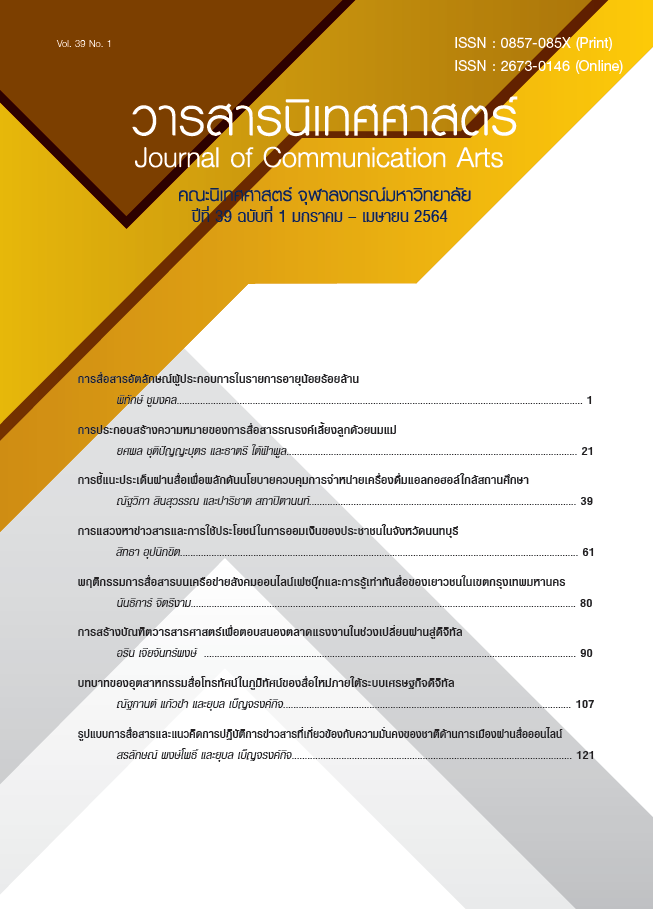Communication of Entrepreneurial Identity in the Television Program "A Yu Noi Roi Lan"
Main Article Content
Abstract
The study is qualitative research aimed to study the identity construction of a young entrepreneurial identity in the "A Yu Noi Roi Lan" (A young hundred-millionaire) Television program. The textual analysis was conducted with twenty-nine episodes broadcast in 2019. Besides, the decoding of the entrepreneurial identity constructed in the program was studied by an in-depth interview with 12 entrepreneurs from purposive sampling.
From the study, it was found from the textual analysis that 1) The program presented business operation in the service sector the most. Most business companies had been operated for more than 1-5 years. 2) The indicator mentioned the most as an accomplishment of business entrepreneurship was a financial success, while the most influential factor in business success was internal organizational factors. 3) The following entrepreneurial identities were found from the study: (3.1) an innovation creator, (3.2) a risk-taker, (3.3) a curious learner, (3.4) an active worker, (3.5) a person with high self-efficacy, (3.6) a person with high persistence to solve a problem, and (3.7) a person with full responsibilities.
Concerning the viewers' decoding of the meaning, most of them viewed the texts with preferred reading, or in the way the program wanted them to, and a part of them decoded the texts' meanings by negotiated meaning. The findings illustrate the influence of television in constructing an entrepreneurial identity effectively to the audience through a narration of the true business experiences of entrepreneurs. Furthermore, the decoding ways of the audience who were entrepreneurs were found to be varied partly by direct experiences or lessons from their business entrepreneurship.
Article Details
References
กันตนา ทองอินทร์. (2558). การนำเอาหลักคำสอนของศาสนาพุทธมาใช้ในการบริหารของนักธุรกิจในภาค ตะวันออกเฉียงเหนือ. วารสารการบริหารท้องถิ่น, 8(1), 16-26.
กาญจนา แก้วเทพ. (2552). สื่อสารมวลชน:ทฤษฎีและแนวทางการศึกษา. กรุงเทพฯ: ห้างหุ้นส่วนจำกัดภาพพิมพ์.
กาญจนา แก้วเทพ. (2548), “หน่วยที่ 6 ทฤษฎีการสื่อสารตามทัศนะของสำนักทฤษฏีวิพากษ์”, ใน ปรัชญานิเทศศาสตร์และทฤษฎีการสื่อสาร, บัณฑิตศึกษา สาขาวิชานิเทศศาสตร์ มหาวิทยาลัยสุโขทัยธรรมาธิราช.
ขวัญฟ้า ศรีประพันธ์. (2551). ภาพตัวแทนคนจนในรายการเกมโชว์ทางโทรทัศน์. วิทยานิพนธ์ดุษฎีบัณฑิตมหาวิทยาลัยธรรมศาสตร์.
จิตติรัตน์ แสงเลิศอุทัย. (2557). ปัจจัยที่ส่งผลต่อแรงจูงใจในการศึกษาต่อสาขาวิชาชีพครูของนักศึกษาชั้นปีที่ 1 มหาวิทยาลัยราชภัฏนครปฐม. วารสารบัณฑิตศึกษา. 11(52): 139-148.
ปิ่นมณี ขวัญเมือง. (2557). หลักอิทธิบาท 4 : เส้นทาง สู่ ความ สำเร็จ. Journal of Industrial Education, 13(3), 1-7.
ปุรินทร์ นาคสิงห์. (2556). การประกอบสร้างตัวตนเกย์ในภาพยนตร์ไทย. วารสารสังคมศาสตร์และมนุษยศาสตร์. 39(2): 35-53.
พิบูล ทีปะปาล. (2552). การเป็นผู้ประกอบการ. กรุงเทพฯ: อมรการพิมพ์.
โพสต์ทูเดย์. (2562). ม.หอการค้าเปิด10อันดับ "ธุรกิจ-อาชีพ" ดาวรุ่งดาวร่วงปี62. วันที่เข้าถึงข้อมูล 31 มีนาคม 2563 แหล่งที่มา https://www.posttoday.com/economy/news/577121
ภาวดี ทิพยรักษ์. (2547). ภาพอาชีพนักข่าวโทรทัศน์ในภาพยนตร์ฮอลลีวู้ดกับที่ปรากฏอยู่ตามประสบการณ์นักข่าวโทรทัศน์ไทย. วิทยานิพนธ์ปริญญามหาบัณฑิต จุฬาลงกรณ์มหาวิทยาลัย.
วริษฐา อุเทศนันท์. (2557). กระบวนการสร้างความเป็นจริงทางสังคมของ "แม่ค้า" ในละครโทรทัศน์. JC Journal. 6(2): 108-124.
ศูนย์วิจัยธนาคารออมสิน. (2562). ธุรกิจร้านอาหาร. วันที่เข้าถึงข้อมูล 31 มีนาคม 2563 แหล่งที่มา www.gsbresearch.or.th/
wpcontent/uploads/2019/10/IN_restaurant_10_62_detail.pdf
สสว. (2560). แผนการส่งเสริมเอสเอ็มอีฉบับที่ 4 (พ.ศ. 2560-2564). กรุงเทพ : สำนักงานส่งเสริมวิสาหกิจขนาดกลางและขนาดย่อม(สสว.).
สาคร สมเสริฐ. (2552). อัตลักษณ์ของมนุษย์เงินเดือน: เปรียบเทียบคนทำงานคอปกขาวกับคนทำงานคอ ปก น้ำเงินของบริษัทผลิตอาหารแห่งหนึ่งในเขตเมือง. Veridian E-Journal, Silpakorn University (Humanities, Social Sciences and arts), 5(2), 690-706.
อชิรญา จงรักษ์. (2555). มายาในโลกมายา: ละครโทรทัศน์กับการสร้างความเป็นจริงทางสังคมของอาชีพในวงการบันเทิง. วิทยานิพนธ์ปริญญามหาบัณฑิต มหาวิทยาลัยธรรมศาสตร์.
อนงค์นาฏ รัศมีเวียงชัย. (2561). การประกอบสร้างรูปแบบการดำเนินชีวิตของวัยทำงานตอนต้นในภาพยนตร์: กรณีศึกษาภาพยนตร์เรื่อง ฟรีแลนซ์...ห้ามป่วยห้ามพัก ห้ามรักหมอ. วารสารศาสตร์. 11(3):102-131.
อภิญญา เฟื่องฟูสกุล. (2546) .อัตลักษณ์ (identity) : การทบทวนทฤษฎีและกรอบแนวคิด. เชียงใหม่: ภาควิชาสังคมวิทยา-มานุษยวิทยา มหาวิทยาลัยเชียงใหม่.
อัญมณี ภักดีมวลชน. (2552). การสื่อสารภาพตัวแทนของคุกชายในภาพยนตร์ไทย : ศึกษากรณี ภาพยนตร์เรื่อง" น.ช. นักโทษชาย".วิทยานิพนธ์ปริญญามหาบัณฑิต มหาวิทยาลัยธรรมศาสตร์.
อิสระพันธ์ ชวันกุล. (2559). แรงจูงใจของนักศึกษาวิชาทหาร ชั้นปีที่ 5 ในกรุงเทพฯที่จะตัดสินใจเข้ารับราชการทหาร. วิทยานิพนธ์มหาบัณฑิต มหาวิทยาลัยศรีปทุม.
อิสริยา อ้นเงิน. (2560). ภาพตัวแทนของข้าราชการในละครโทรทัศน์. วิทยานิพนธ์ปริญญามหาบัณฑิต มหาวิทยาลัยธรรมศาสตร์.
Brandbuffet. (2562). เทรนด์ใหม่ผู้ประกอบการ “เถ้าแก่วัยเก๋า” ส่วนกลุ่ม “อายุน้อย” เริ่มปั้นธุรกิจตั้งแต่ ม.ต้น พร้อมอินไซต์ และ Mindset ทำธุรกิจให้สำเร็จ. วันที่เข้าถึงข้อมูล 29 มีนาคม 2563 แหล่งที่มา https://www.brandbuffet.in.th/
/07/trend-and-insight-thai-sme-2019/
Berger, Peter L. and Luckmann, Thomas. (1966). The social construction of reality. New York: Dobleday.
Cornell University, INSEAD, and WIPO (2015). The Global Innovation Index 2015: Effective Innovation Policies for Development, Fontainebleau, Ithaca, and Geneva.
Dess, G. G., Lumpkin, G.T., & Taylor, M. L. (2005). Strategic management: Creating competitive advantage. New York: McGraw-Hill.
Esteves, J., & De Haro, G. (2016). Meet the Teenagers Who Found Their Own Startups. Harvard Business Review. https://hbr.org/2016/12/meet-the-teenagers-who-found-their-own-startups
Hall S. (1980). “Encoding/decoding.” In Stuart Hall. Et al. (eds.), Culture, Media, Language. London: Unwin Hyman.
Hall S. (1990). Identity, Community, Cultural, Difference. London: Lawerence and Wishant.
Jones, R.G. and George, M.J. (2003). Contemporary Management. New York: McGraw – Hill.
Kaplan R.S. and Norton D.P. (1992). “The Balanced Scorecard - Measures That Drive Performance”, Harvard Business Review, 70(Jan-Feb).
Littlejohn, Stephen W. (1992). Theories of Human Communication. California: Wadsworth.
Zoltners, A. A., Sinha, P., & Lorimer, S. E. (2006). Match your sales force structure to your business life cycle. Harvard business review, 84(7/8), 80.


